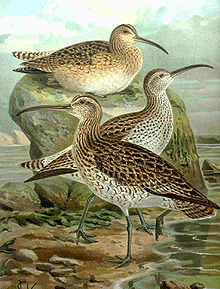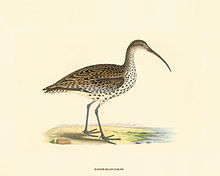- Slender-billed Curlew
-
Slender-billed Curlew 
Illustration from ca 1830 Conservation status Scientific classification Kingdom: Animalia Phylum: Chordata Class: Aves Order: Charadriiformes Family: Scolopacidae Genus: Numenius Species: N. tenuirostris Binomial name Numenius tenuirostris
Vieillot, 1817The Slender-billed Curlew, Numenius tenuirostris, is a bird in the wader family Scolopacidae. It breeds in marshes and peat bogs in the taiga of Siberia, and is migratory, formerly wintering in shallow freshwater habitats around the Mediterranean. This species has occurred as a vagrant in western Europe, the Canary Islands, the Azores, Oman, Canada and Japan.
Contents
Description
Appearance
 Slender-billed Curlew (centre) between Whimbrels.
Slender-billed Curlew (centre) between Whimbrels.
The Slender-billed Curlew is a medium-sized curlew, 36–41 cm in length with a 77–88 cm wingspan. It is therefore about the same size as a Whimbrel, but it is more like the Eurasian Curlew in plumage. The breeding adult is mainly greyish brown above, with a whitish rump and lower back. The underparts are whitish, heavily streaked with dark brown. The flanks have round or heart-shaped spots. The non-breeding plumage is similar, but with fewer flank spots. Male and female are alike in plumage, but females are longer-billed than males, an adaptation in curlew species that avoids direct competition for food between the sexes. The juvenile plumage is very similar to the adult, but the flank are marked with brown streaking, the heart-shaped spots only appearing towards the end of the first winter.
Compared to the Eurasian Curlew, the Slender-billed Curlew is whiter on the breast, tail and underwing, and the bill is shorter, more slender, and slightly straighter at the base. The arrowhead-shaped flank spots of the Eurasian Curlew are also different from the round or heart-shaped spots of the Slender-billed. The head pattern, with a dark cap and whitish supercilium, recalls that of the Whimbrel, but that species also has a central crown stripe and a more clearly marked pattern overall; the pattern of the Slender-billed Curlew would be hard to make out in the field.
This species shows more white than other curlews, and the white underwings, along with the distinctive flank markings, are key identification criteria.
Vocalisations
The call is a cour-lee, similar to that of the Eurasian Curlew but higher-pitched, more melodic and shorter. The alarm call is a fast cu-ee.
Behavior
Little is known about the breeding biology, but the few nests observed had on average four eggs.
Slender-billed Curlews feed by using their bills to probe soft mud for small invertebrates, but will also pick other small items off the surface if the opportunity arises. It used to be highly gregarious outside the breeding season, associating with related species, particularly Eurasian Curlews.
Status
After a long period of steady decline, the Slender-billed Curlew is extremely rare, with only a minute and still declining population. This is thought to be under 50 adult birds, with no more than two or three verified sightings in any year in the last five (as of 2007[update]). As a result it is now listed as critically endangered. It is actually the first European bird species highly likely to become entirely extinct since the last Great Auk died over 150 years ago.
The primary cause of the decline is thought to be excessive hunting on the Mediterranean wintering grounds. Habitat loss, particularly in the wintering grounds, may also have played a part, but huge areas of forest bogs suitable for breeding still exist in Siberia. It is unknown to what extent the birds still reproduce successfully, and how much gene flow still exists in what may once have been a large and widely dispersed population undergoing little purging of deleterious recessive alleles and consequently with a high MVP. Furthermore, although there is evidence that birds in winter quarters were more numerous once and in general not a very rare sight in Western Europe in the 19th century and were hunted with some regularity - and later on also threatened by pollution, e.g. oil spills -, there is no data how these threats endanger the species today exist. Theoretically they might have retreated to all but inaccessible areas, but then, a single hunter might unwittingly wipe out enough of the few remaining birds to doom the species.
The only well documented nest was found in 1924, near Tara in Omsk oblast, Siberia (57°N 74°E / 57°N 74°E).[2] Its nesting grounds since then remain unknown, despite several intensive searches (not surprising, with over 100,000 square kilometres to search). The extent of its decline is also reflected in the absence of wintering birds at previously regular Moroccan sites.
More recently, 20 birds were recorded in Italy in 1995. Remarkably, there is also a single recent (4–7 May 1998) record of an immature (one year old) at Druridge Pools in Northumberland, England,[3] for details of which see the Druridge Bay curlew.
Slender-billed Curlews have been reported in various Western Palearctic locations on a number of occasions since the Druridge bird, including claimed, but unverified, sightings of single birds from Italy and Greece; none have been documented with conclusive photographs and at least one claimed bird, at RSPB Minsmere, Suffolk, England in 2004, is now widely believed to have been a Eurasian Curlew.
Further sourced reports of the species were published in 2007, in British Birds magazine;[4] the article stated, quoting from Zhmud[5]:
During the last few years, small groups of birds have been found in the northern coastal areas [of the Danube Delta], frequenting low-lying islands, bays and sand-spits covered with Common Glasswort Salicornia europaea [...] Four birds were present from 25th July to 21st August 2003, six were seen on 11th August 2004, and another on 12th August 2004.
A sighting of a single bird was reported from Albania in 2006 by a team including ornithologists from the environmental organization EuroNatur.
Thus, though hard proof is lacking but given the extent of possible habitat and the precautionary principle, it is believed to be extant for the time being. Apparently at least the wintering range has starkly contracted; it appears that the handful of family or neighbor groups that are left retreat to remote habitat in southeastern Europe in winter. The IUCN classifies it as Critically Endangered (CR) C2a(ii); D. This means that an estimated 50 mature birds or less are believed to exist, with numbers declining, and that there is probably only one subpopulation.
References
General references
- Hayman, Peter; Marchant, John & Prater, Tony (1986): Shorebirds: an identification guide to the waders of the world. Houghton Mifflin, Boston. ISBN 0-395-60237-8
- Svensson, Lars; Zetterström, Dan; Mullarney, Killian & Grant, P. J. (1999): Collins bird guide. Harper & Collins, London. ISBN 0-00-219728-6
Identification
- Identification of Slender-billed Curlew, John Marchant, British Birds 77: 135-140.
- Slender-billed Curlew studies, Richard Porter, British Birds 77: 581-586.
- Slender-billed Curlews in Morocco, Arnoud van den Berg, British Birds 83: 1-7.
- Slender-billed Curlew in Tunisia in Feb 1984, Eddy Wijmengs & Klaas van Dijk, Dutch Birding 7: 67-68.
- Slender-billed Curlews in Morocco in Feb 1979, Peter Ewins, Dutch Birding 11: 119-120.
- Identification of Slender-billed Curlew and its occurrence in Morocco in winter 1987/88, Arnoud van den Berg, Dutch Birding 10: 45-53.
- Slender-billed Curlew on Sicily in March 1996, Andrea Corso, Dutch Birding 18: 302.
- Slender-billed Curlew collected at Canis-vliet in September 1896, Gunter De Smet, Dutch Birding 19: 230-232.
- The identification of the Slender-billed Curlew, British Birds Vol 56 No8 1963
Specific references
- ^ BirdLife International (2004). Numenius tenuirostris. 2006. IUCN Red List of Threatened Species. IUCN 2006. www.iucnredlist.org. Retrieved on 4 April 2007. Database entry includes justification for why this species is critically endangered
- ^ Gretton, Adam; Yurlov, Alexander K. & Boere, Gerard C. (2002): Where does the Slender-billed Curlew nest, and what future does it have? British Birds 95(7): 334-344 ISSN 0007-0335 HTML abstract
- ^ Cleeves, Tim (2002): Slender-billed Curlew in Northumberland: new to Britain and Ireland. British Birds 95(6): 272-299 (2002) ISSN 0007-0335 HTML abstract
- ^ Goriup, Paul; Baboianu, Grigore & Chernichko, Joseph (2007): The Danube Delta: Europe's remarkable wetland British Birds 100: 194-213 ISSN 0007-0335
- ^ Zhmud, M. 2005: Slender-billed Curlew: promising discovery in the Danube delta Wader Study Group Bull. 106: 51-54
External links
- ARKive: Photographs of Slender-billed Curlew (Numenius tenuirostris). Retrieved 2007-APR-06.
- BirdLife International: Species factsheet. Retrieved 2007-APR-06.
- BirdLife International: Additional data. Retrieved 2007-APR-06.
- British Ornithologists' Union Records Committee: Slender-billed Curlew at Druridge Pools accepted as first for Britain (with photo). Retrieved 2007-APR-06.
- Photos from Morocco. Retrieved 2007-APR-06.
- The RSPB project: Slender-billed Curlew.
- Surfbirds.com: The Slender-billed Curlew in Northumberland, 1998 - 'plate 164' - response by the British Birds Rarities Committee and more photos of the "Druridge Bay curlew". Retrieved 2007-APR-06.
- Convention on Migratory Species: Slender-billed Curlew Memorandum of Understanding
- CIC - International Council for Game and Wildlife Conservation: CIC Species Conservation: Slender-billed Curlew
Categories:- IUCN Red List critically endangered species
- Curlews
- Numenius
- Birds of Europe
- Birds of Turkey
Wikimedia Foundation. 2010.


